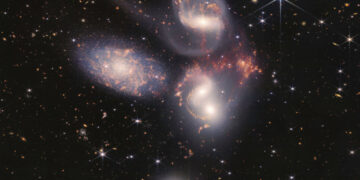For years, scientists have been fascinated by the influence of cosmic forces on Earth. From the impact of solar activity on our climate to the effects of radiation on human technology, space is not as distant as it seems. Now, an intriguing study suggests that deep space cosmic rays may have played a role in shaping the evolution of viruses on Earth—specifically, those infecting fish in Africa’s Lake Tanganyika.
What Are Cosmic Rays? The Universe’s High-Energy Messengers
Cosmic rays are high-energy particles that originate from some of the most violent events in the universe, including supernovae, black holes, and even mysterious forces beyond our galaxy. These particles travel at nearly the speed of light, carrying enormous energy across vast cosmic distances.
When cosmic rays reach Earth, they collide with the atmosphere, creating showers of secondary particles. Most of these are absorbed by our planet’s protective magnetic field and atmosphere, but some manage to reach the surface. While their presence is usually harmless, they have been known to interfere with satellites, affect climate patterns, and even alter DNA.
The Cosmic Event That Might Have Changed Earth
Evidence of a supernova event around 2.5 million years ago has been discovered in the form of radioactive iron-60 deposits in deep-sea sediments. Iron-60 is a rare isotope that only forms in massive stellar explosions. The presence of this isotope on Earth suggests that our planet was exposed to intense cosmic radiation for roughly 100,000 years.
According to researchers, this period of heightened cosmic activity coincides with an evolutionary burst in viruses found in fish within Lake Tanganyika.
How Cosmic Rays Influence Evolution
Radiation, including cosmic rays, can directly alter genetic material by breaking DNA strands. This can lead to mutations, some of which may be harmful, but others can drive evolution by introducing genetic diversity.
While mutations typically occur at a slow and steady rate, certain environmental factors—such as increased radiation exposure—can accelerate the process. The idea that cosmic rays might have played a role in virus evolution is based on this principle.
Prior studies have already established that exposure to cosmic radiation can affect cellular structures, increase mutation rates, and even impact biological development. However, this study is the first to suggest that such cosmic activity may have played a direct role in viral evolution.
A Surprising Link Between Space and Biology
The research team behind this study remains cautious in their conclusions. While they cannot claim definitive proof that the supernova-induced cosmic rays were responsible for the observed viral diversification, the timeline presents an intriguing possibility.
“We can’t say that they are connected, but they have a similar timeframe,” said lead researcher Caitlyn Nojiri from UC Santa Cruz.
The discovery highlights the importance of interdisciplinary research, where astrophysics and evolutionary biology converge to explore unexpected connections between cosmic events and life on Earth.
Lake Tanganyika: A Unique Evolutionary Laboratory
Lake Tanganyika, the world’s second-largest and second-deepest freshwater lake, provides an excellent environment for studying long-term evolutionary changes.
● Isolated Ecosystem: Due to its geographical isolation, Lake Tanganyika has housed stable populations of fish and other aquatic species for millions of years.
● Limited External Influences: Unlike oceans, the lake is relatively untouched by external marine influences, making it an ideal location for studying evolutionary shifts.
● Exceptional Biodiversity: The lake is home to hundreds of unique species, many of which exist nowhere else on Earth.
This setting makes Lake Tanganyika a perfect case study for observing how genetic variations emerge and spread within an ecosystem.
The Role of Supernovae in Earth’s History
While this study focuses on viral evolution, cosmic events such as supernovae have likely influenced life on Earth in more significant ways:
- Mass Extinctions: Some scientists propose that past mass extinctions may have been triggered by nearby supernovae that increased cosmic radiation exposure, potentially affecting climate and ecosystems.
- Genetic Evolution: Cosmic rays may have influenced not only viruses but also the genetic evolution of larger organisms, including mammals and early humans.
- Climate Shifts: Some theories suggest that cosmic radiation affects cloud formation and climate patterns, potentially influencing evolutionary pressures on different species.
If supernovae can influence such fundamental processes, their role in shaping life on Earth could be much greater than we previously thought.
What Could This Mean for the Future?
While the supernova event that may have influenced Earth’s past occurred millions of years ago, modern scientists are monitoring the skies for similar occurrences. Although the chances of another nearby supernova significantly impacting Earth in the near future are low, it remains a fascinating possibility.
This research opens the door for further studies into how cosmic forces might continue to shape biological evolution. Scientists are now looking at other periods in Earth’s history to see if similar correlations exist between cosmic events and bursts of evolutionary activity.
Future missions aimed at studying cosmic radiation, such as those conducted by the European Space Agency and NASA, may provide more insights into how space influences life on our planet.
Final Thoughts: The Cosmic Web of Life
The idea that cosmic rays—originating from exploding stars millions of light-years away—could have influenced the evolution of viruses in a freshwater lake on Earth is both mind-boggling and exhilarating.
Reference:



















